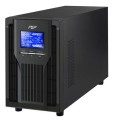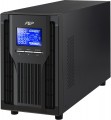Full load operating time
UPS continuous operation time from a fully charged battery when connected to a load with a power equal to the UPS output power (maximum or effective, depending on the type of load, see the relevant paragraphs for details). For a UPS designed to work with a home or office PC, a time of about 10-15 minutes is considered sufficient, this is enough to save data and complete work. To power servers, it is worth using devices with an operating time
of 20 minutes or more.
Half load operating time
UPS continuous operation time from a fully charged battery when connected to a load with a power equal to half the output power of the UPS (maximum or effective, depending on the type of load, see below for details). The operating time with such a load is much longer than for a full load, and even in the simplest models it can reach 20-30 minutes.
Input voltage range
In this case, the input voltage range is implied, in which the UPS is able to supply a stable voltage to the load only due to its own regulators, without switching to the battery. For redundant UPSs (see "Type") this range is quite small, approximately 190 to 260 V; for interactive and especially inverter ones, it is much wider. Some UPS models allow you to manually set the input voltage range.
Output voltage accuracy
This parameter characterizes the degree of difference between the AC voltage at the output of the UPS and the perfect voltage, the graph of which has the shape of a regular sinusoid. The perfect voltage is so named because it is the most uniform and creates the least unnecessary load on the connected devices. Thus, the distortion of the output voltage is one of the most important parameters that determine the quality of the power received by the load. A distortion level of 0% means that the UPS produces a perfect sine wave, up to 5% — slight sine wave distortion, up to 18% — strong distortion, from 18% to 40% — a trapezoidal signal, more than 40% — a square wave.
Redundant sockets
The number of
outlets connected to the power reserve(battery) provided in the design of the UPS. In order for the UPS to fulfill its main role (providing a backup power in case of power outages), the corresponding electrical appliances must be connected to these outlets. The sockets have a standard shape and are compatible with the vast majority of popular 230 V plugs.
At a minimum, the UPS has
1 or
2 outlets and, in more advanced ones, there may be
3 or
more.
Socket type
A socket for a specific type of plug in the UPS design.
—
Type F (Schuko). A traditional European socket with two round holes in the center and grounding contacts in the form of two metal brackets (at the top and bottom of the socket). The term Schuko stuck to this type of socket due to the abbreviation from the German Schutzkontakt - protective contact.
—
Type E (French). The French style socket has two round holes and a protruding ground pin just above them in the center. The standard has become widespread in France, Poland and Belgium (along with the traditional type F sockets).
—
Type G (British). The plug for such sockets consists of two flat horizontal pins and one flat vertical pin for grounding. The standard is found mainly in the countries of the United Kingdom, Malta, Cyprus, Singapore and Hong Kong.
—
Type B (American). American-style sockets are designed for plugs with two flat prongs and a semicircular grounding contact. Type B is widely used in regions with voltage 110 - 127 V - USA, Japan, Saudi Arabia, etc.
Reserved C13/C14 connectors
Number of
C13/C14 connectors with power reserve provided in the UPS design.
Electrical appliances connected to connectors with a reserve are insured against a power failure in the network - in this case they switch to the battery. The C13/C14 connector itself is also known as a “computer socket”; it supplies the same 230 V as a regular household network, but is not compatible with plugs for traditional sockets, because uses three flat contacts. However, there are adapters between these standards.
At a minimum, the UPS is provided with
1,
2 or
3 C13/C14 connectors for one workstation. In more advanced, so to speak office ones, the number of C13/C14 connectors may be greater -
4 ports,
6 connectors,
8 and even more
1st battery voltage
The value of the operating voltage of one complete battery. In most cases, it is 12 V, UPS with 24-volt batteries is a little less common.
Control interfaces
Many modern UPSs can be connected to a computer or other special devices. This provides advanced options for monitoring the parameters of the UPS and managing its functions: without leaving the computer, you can monitor the battery status, network parameters, load, enable special modes, apply automatic adjustment, etc. Such a connection can be made according to the following standards:
—
RS-232. It's a COM port. Initially designed to connect various peripherals to a computer. Today it is also quite widespread, however, due to its relatively large size, it is installed mainly on stationary PCs.
—
USB. A universal port for connecting various peripherals to a computer, the most popular interface of this kind today — at least one USB port has an absolute majority of computers and laptops.
-LAN. A port used to connect to wired computer networks. Models with this interface can often be connected as a network device, which allows, if necessary, to control them from any computer on this network.
—
SmartSlot. A slot in the UPS case for installing expansion cards (SmartSlot cards). The development of APC, is used mainly in the devices of its production. Such cards can provide a very diverse set of features: additional connection ports beyond the standard ones (for example, a LAN control port), a web managemen
...t interface, support for SNMP, Secure HTTP and other protocols, connection of temperature / humidity sensors, and much more. To date, a wide range of cards is being produced, making it easy to choose a set of additional functions depending on the specific situation. Most UPS models have one SmartSlot, but if necessary, you can use a special expander and install two cards, and the largest models can have two slots as standard.
— "Dry contact". In uninterruptible power supplies, the term "dry contact" refers to a professional interface used to transfer data on the operation of the UPS to specialized external equipment. Such an interface usually has a whole set of contacts (on the order of 10), often in the form of terminals. And the scheme of its operation can be simply described as follows: when certain parameters are reached, the control relay closes or opens a given set of “dry contacts”, on the basis of which the control device receives information about one or another parameter of the UPS operation.
